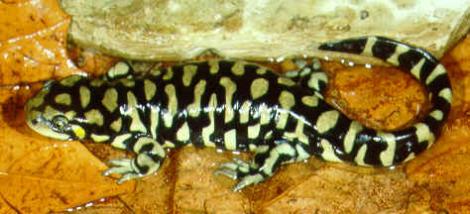 SKC Films Library SKC Films Library |
| SKC Films Library >> Science >> Zoology >> Reptiles and Amphibians >> Order Caudata |
| Tiger Salamander Ambystoma tigrinum Description The tiger salamander is a thick-bodied animal with a rather large head and broad rounded snout. The body is usually yellowish or olive with dark spots. Those spots are never in any set shape, size, or position. Experts can usually tell where any individual tiger salamander "hails from" based on the color and pattern of the background and/or spots. Males are proportionately longer, with a more compressed tail and longer, stalkier hind legs than females. The largest terrestrial salamander in the world, a fully grown male may be up to 14 inches in length.
Distribution and Habitat Tiger salamanders range from southeastern Alaska east to the southern part of Labrador, and south throughout all of the United States down to the southern edge of the Mexican Plateau. Depending on the specific sub-species, this salamander inhabits forests, grasslands, or marshy areas, as long as there is soil in which they can burrow. Like other amphibians, the tiger salamander must have access to pools of water in order to lay its eggs, but those pools need not be permanent. Reproduction Tiger salamanders migrate to breeding ponds in late winter or early spring, usually after a warm rain that thaws out the ground's surface. Courtship takes place at night, with the male doing most of the courting. Eggs are laid in small pools, and attached to twigs, grass stems or leaves. An egg mass may contain up to 100 eggs, with each female producing from 100 to 1,000 eggs per season. The time period between laying and hatching can be anywhere from 19 to 50 days, depending on climate. Larvae are yellowish green or olive, with dark blotches and a stripe along each side. They remain in the birth pool until 2.5 to 5 months of age, but will retain their gills into adulthood if the conditions are unfavorable outside their birthplace. Tiger salamanders live up to 16 years in the wild. Habits and Behaviors Adult tiger salamanders spend most of their life underground, spending their days in burrows in order to escape the temperature extremes on the surface, coming out only at night in order to feed. They are more active in spring and fall. Diet Worms, snails, insects and slugs make up most of the adult tiger salamander's diet. Larval salamanders feed on small crustaceans and insect larvae, moving up to tadpoles, smaller salamander larvae and small fish as they mature. Other Information The barred tiger salamander is the official state amphibian of Kansas. Scientific Classification phylum Chordata SOURCE |
| SKC Films Library >> Science >> Zoology >> Reptiles and
Amphibians >> Order Caudata This page was last updated on June 10, 2017. |
